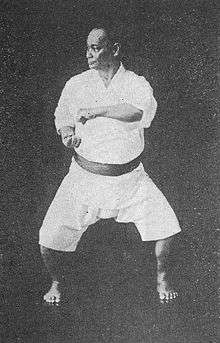Horse stance
The Horse Stance (sometimes called Horse Riding Stance) is an important posture in Asian martial arts and takes its name from the position assumed when riding a horse. It is called mǎbù (馬步) in Chinese, kiba-dachi (騎馬立ち) in Japanese, kuda-kuda or kekuda in Malay and Indonesian, and juchum seogi (주춤 서기) or annun seogi (lit. sitting stance) in Korean. This stance can not only be integrated into fighting but also during exercises and forms. It is most commonly used for practicing punches or to strengthen the legs and back.
Chinese martial arts

Mabu is used for endurance training as well as strengthening the back and leg muscles, tendon strength, and overall feeling and understanding of "feeling grounded". It is a wide, stable stance with a low center of gravity.
Northern styles
The ideal horse stance in most northern Chinese martial arts (such as Mizongquan and Chaquan) will have the feet pointed forward, thighs parallel to the floor, with the buttocks pushed out, and the back "arched up" to keep the upper body from leaning forward. The emphasis on this latter point will vary from school to school as some schools of Long Fist, such as Taizu and Bajiquan, will opt for the hips forward, with the buttocks "tucked in."
In Northern Shaolin, the distance between the feet is approximately two shoulder widths apart.
Southern Shaolin
In Southern Shaolin, a wide horse riding stance is assumed as if riding a horse. The reason for this is that southern Chinese martial arts were designed to be used whilst fighting on boats and barges. The wide posture was created for greater stability in such conditions. The horse stance in southern Chinese systems is commonly done with the thighs parallel to the ground and the toes pointing forward or angled slightly out.
Some southern Chinese styles (such as Hung Gar) may be known for their deep and wide horse stance, but the southern Horse Stance is generally higher than that practiced in northern styles.
See also Wushu Stances for more information.
Japanese martial arts

In Japanese martial arts, the horse stance (kiba-dachi) has many minor variations between individual schools, including the distance between the feet, and the height of the stance. One constant feature is that the feet must be parallel to each other.
Note that the horse stance differs from the straddle stance (四股立ち shiko-dachi), widely used in sumo, in which the feet point outward at 45 degrees rather than being parallel.
Indian martial arts
What is referred to as the horse stance in south Indian martial arts is very different from the posture of the same name in other Asian fighting styles. Known in Malayalam as aswa vadivu or ashwa vadivu, it imitates the horse itself rather than the rider. In kalaripayat, the horse stance has the hind leg stretched completely backward while the knee of the front leg is bent ninety degrees. The horse stance is the main posture of the Shiva form and is related to the virabhadrasana (warrior pose) in yoga.
Efficacy
Bruce Lee was a harsh critic of the combat utility of the stance.[1]
References
- ↑ Charles, Russo (Oct 3, 2016). "Bruce Lee vs. Wong Jack Man: Fact, Fiction and the Birth of the Dragon". Fightland. Retrieved Oct 6, 2016.
External links
- Horse Stance Demo Horse stance demonstration
- Kalari Animal Posture - Horse Horse stance of kalaripayat
- Southern Shaolin Horse Stance - correct technique and training program Southern Shaolin Horse Stance - correct technique and training program